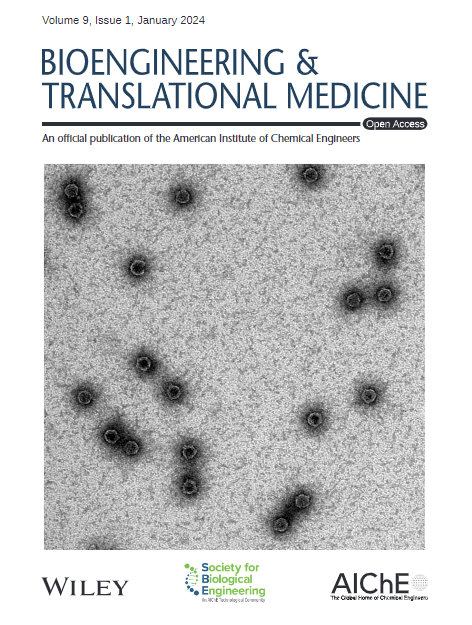光交联GelMA水凝胶联合线粒体移植增强大鼠脊髓损伤修复
IF 6.1
2区 医学
Q1 ENGINEERING, BIOMEDICAL
引用次数: 0
摘要
急性脊髓损伤(SCI)诱导线粒体氧化应激、细胞生物能量危机、蛋白质降解受损以及随后的变性,导致神经元易损性增加。外源线粒体移植到损伤部位可减轻细胞能量危机和对抗神经退行性变;然而,线粒体移植的有限疗效限制了其治疗潜力。在这项研究中,我们在大鼠T10胸段建立了右侧脊髓半切模型,并在损伤部位移植了含有活性线粒体的甲基丙烯酸酯明胶(GelMA)水凝胶,以评估其治疗效果和潜在机制。我们的研究结果表明,与单独的线粒体移植相比,GelMA水凝胶联合线粒体移植对脊髓损伤的治疗效果更好。GelMA水凝胶能够在损伤部位持续释放线粒体,提供能量,上调NF200表达,促进轴突再生。此外,它还能促进M2巨噬细胞的积累,改善局部炎症微环境。GelMA水凝胶的结构框架进一步支持轴突再生。足迹步态分析和Basso, Beattie, and Bresnahan (BBB)运动评分显示GelMA水凝胶联合线粒体移植可显著改善脊髓损伤大鼠右后肢运动功能。因此,GelMA水凝胶联合线粒体移植为治疗脊髓损伤提供了一种可行且有前景的方法。本文章由计算机程序翻译,如有差异,请以英文原文为准。
Enhancement of spinal cord injury repair in rats using photo‐crosslinked GelMA hydrogel combined with mitochondrial transplantation
Acute spinal cord injury (SCI) induces mitochondrial oxidative stress, cellular bioenergetic crises, impaired protein degradation, and subsequent degeneration, resulting in increased neuronal vulnerability. Transplantation of exogenous mitochondria to the injury site mitigates cellular energy crises and counteracts neurodegeneration; however, the limited efficacy of mitochondrial transplantation alone constrains its therapeutic potential. In this study, we established a right‐sided spinal cord hemisection model at the T10 thoracic segment in rats and transplanted a methacrylate‐based gelatin (GelMA) hydrogel containing active mitochondria at the injury site to assess its therapeutic effects and underlying mechanisms. Our findings indicate that GelMA hydrogel combined with mitochondrial transplantation provides superior therapeutic benefits for SCI compared to mitochondrial transplantation alone. GelMA hydrogel enables sustained mitochondrial release at the injury site, supplying energy, upregulating NF200 expression, and promoting axonal regeneration. Additionally, it enhances M2 macrophage accumulation and improves the local inflammatory microenvironment. The structural framework of GelMA hydrogel further supports axonal regeneration. Footprint gait analysis and Basso, Beattie, and Bresnahan (BBB) motor scoring demonstrated that GelMA hydrogel combined with mitochondrial transplantation significantly improves motor function in the right hind limb of rats with SCI. Consequently, GelMA hydrogel combined with mitochondrial transplantation offers a viable and promising approach for treating spinal cord injury.
求助全文
通过发布文献求助,成功后即可免费获取论文全文。
去求助
来源期刊

Bioengineering & Translational Medicine
Pharmacology, Toxicology and Pharmaceutics-Pharmaceutical Science
CiteScore
8.40
自引率
4.10%
发文量
150
审稿时长
12 weeks
期刊介绍:
Bioengineering & Translational Medicine, an official, peer-reviewed online open-access journal of the American Institute of Chemical Engineers (AIChE) and the Society for Biological Engineering (SBE), focuses on how chemical and biological engineering approaches drive innovative technologies and solutions that impact clinical practice and commercial healthcare products.
 求助内容:
求助内容: 应助结果提醒方式:
应助结果提醒方式:


